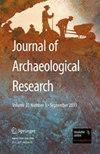古代世界的水产养殖:生态系统工程、驯化景观和第一次蓝色革命
IF 4.1
1区 历史学
Q1 ANTHROPOLOGY
引用次数: 0
摘要
水产养殖是世界上发展最快的粮食部门,占世界鱼类食品供应量的50%以上。自20世纪中叶以来,全球水产养殖的显著增长被称为“蓝色革命”。然而,这并不是人类历史上发生的第一次蓝色革命。虽然在历史上,海洋食物在考古话语中被归类为低级、季节性或饥饿资源,但海洋食物是古代社会利用各种策略开发和利用的重要资源。在这些水生策略中包括水产养殖。第一次蓝色革命始于大约8000年前的中国全新世早期,考古学家现在记录了全球范围内的水产养殖。这篇综述考虑了古代水产养殖系统之间的共性,包括生态系统工程的证据和驯化景观作为生产系统的发展。过去的人们构建农业生态系统,不仅是为了丰富和多样化水产资源,也是为了控制关键生存食物的可靠性,满足仪式实践和明显的社会分层的需要。这些水产养殖系统维持了几个世纪,如果不是几千年的话。对古代水产养殖进行的全球研究可以为今天沿海社区开发更具生态可持续性、弹性和多样性的海洋生产系统提供重要见解,从而实现产业可持续性,并限制对世界海岸线和过度开发渔业的负面环境影响。本文章由计算机程序翻译,如有差异,请以英文原文为准。
Aquaculture in the Ancient World: Ecosystem Engineering, Domesticated Landscapes, and the First Blue Revolution
Abstract Aquaculture is the world’s fastest growing food sector and accounts for more than 50% of the world’s fish food supply. The significant growth in global aquaculture since the middle of the 20th century has been dubbed by the Blue Revolution. However, it is not the first Blue Revolution to take place in human history. While historically classified as low-ranking, seasonal, or starvation resources in the archaeological discourse, marine foods were vital resources that ancient communities developed and exploited using a vast array of strategies. Among these aquatic strategies was aquaculture. This first Blue Revolution was initiated during the Early Holocene, some 8,000 years ago in China, with archaeologists now documenting aquaculture across the globe. This review considers the commonalities between ancient aquacultural systems including evidence of ecosystem engineering and the development of domesticated landscapes as production systems. People of the past constructed agroecosystems to not only enhance and diversify aquatic resources, but to control the reliability of key subsistence foods and to meet the demands of ritual practice and conspicuous social stratification. These aquaculture systems were maintained for centuries, if not millennia. Worldwide research conducted on ancient aquaculture can provide critical insights into developing more ecologically sustainable, resilient, and diverse marine production systems for coastal communities today, thus, achieving industry sustainability and limiting negative environmental impacts to the world’s shorelines and overexploited fisheries.
求助全文
通过发布文献求助,成功后即可免费获取论文全文。
去求助
来源期刊

Journal of Archaeological Research
Multiple-
CiteScore
10.20
自引率
7.90%
发文量
9
期刊介绍:
Journal of Archaeological Research publishes the most recent international research summaries on a broad range of topics and geographical areas. The articles are intended to present the current state-of-the-discipline in regard to a particular geographic area or specific research topic or theme. This authoritative review journal improves access to the growing body of information and literature through the publication of original critical articles, each in a 25-40 page format.2-Year Impact Factor: 4.056 (2017) 5-Year Impact Factor: 4.512 (2017)2 out of 85 on the Anthropology listIncluded in the European Reference Index for the Humanities (ERIH) PLUS The European Reference Index for the Humanities and the Social Sciences (ERIH PLUS) was created and developed by European researchers under the coordination of the Standing Committee for the Humanities (SCH) of the European Science Foundation (ESF). https://dbh.nsd.uib.no/publiseringskanaler/erihplus/about/indexSCImago Journal and Country Rank (SJR) 2018: 1.7102 out of 263 on the Archeology (Arts and Humanities) list3 out of 254 on the Archeology list2 out of 131 on the General Arts and Humanities listSJR is a measure of the journal’s relative impact in its field, based on its number of citations and number of articles per publication year.Source Normalised Impact per Paper (SNIP) 2018: 2.112The SNIP measures contextual citation impact by weighting citations based on the total number of citations in a subject field. The impact of a single citation is given higher value in subject areas where citations are less likely, and vice versa.CiteScore 2018: 3.86Rated ''A'' in the Australian Research Council Humanities and Creative Arts Journal List. For more information, visit: http://www.arc.gov.au/era/journal_list.htm
SCImago Journal and Country Rank (SJR) 2011 1.227 Archeology 1 out of 96 Archeology (Arts and Humanities) 1 out of 59 Arts and Humanities (miscellaneous) 1 out of 243
 求助内容:
求助内容: 应助结果提醒方式:
应助结果提醒方式:


